(Brought this post up front today due to making an oval adapted shaft for BCA shovels.)
I’m getting tired of shovel makers not using more composites. Thought I’d whip up a few custom shovel shafts and see how they work for spring and summer backcountry skiing. In the case of the full carbon shaft, weight savings is in my view significant. When adapting using aluminum tubing section, not so much. Check it all out.
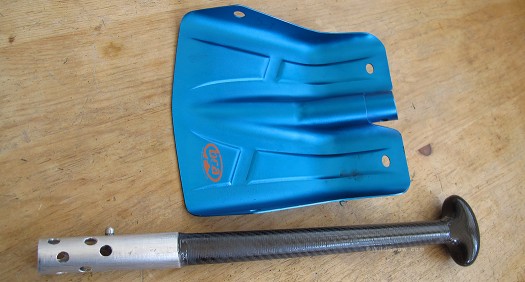
BCA B-1 shovel blade with custom adapted carbon shaft (adaption due to oval shape of OEM shaft), saves more than 2 ounces over stock, shaft length same as OEM non-extend version. Significant? You be the judge. If done commercially, weight savings could easily be along the lines of 4 to 5 ounces, and quite a bit more for an extendable shaft. Using some sort of aluminum sleeve over the carbon could be the answer to potential wear problems at shovel/blade interface, but the alu would need to be thin so as not to cancel out the weight savings. By the way, these new BCA shovels are the thing -- custom shafts or not.
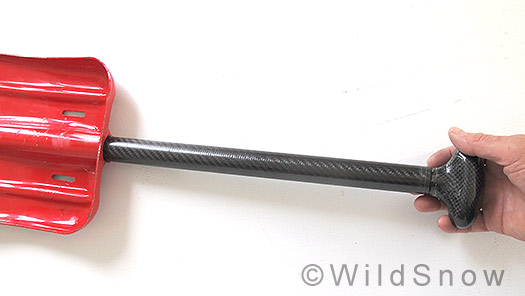
Carbon fiber avalanche shovel shaft, with carbon handle, on G3 shovel. In this case the weight savings was good due to not needing an adapter. But this shovel blade is a few ounces heavier so the savings got canceled out.
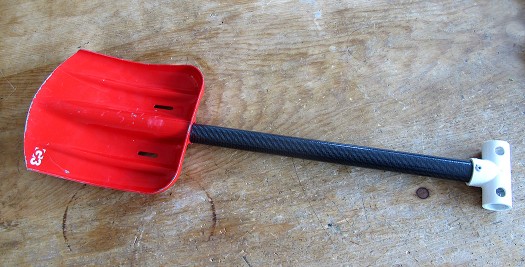
Home-made carbon fiber shovel shaft on G3 Guide shovel blade. This shaft was made with a PVC plumbing pipe T handle, which weighs a few ounces more than the carbon handle but costs 70 times less.
To begin, 1 inch carbon fiber tubing was acquired from one-of webstore. Took a while to find the right pick, and I’m not sure if this stuff is tubing or pipe. It measures .999 inch ID and 1.12 OD, which happens to fit perfectly in a G3 shovel, probably because the G3 shaft socket is bored out to 28.5 mm. The tubing was tested to destruction by wedging the shovel under my backyard deck, inserting tube in shovel socket, then yarding on the shaft until it broke with a pop as loud as my hunting rifle. This was then compared to a regular shaft tortured with the same NRA approved methodology. (Only the G3 Guide shovel could have held up to this abuse, by the way…)
Strength testing conclusion is the carbon fiber tube I chose is easily as strong as the aluminum shaft, and thus fine for an occasional-use backcountry skiing shovel, though one would have to keep a sharp eye on it for abrasions and gouges as it’s said the composite is more sensitive to such abuse than alu. (More, note that the G3 shovel blade is one of the strongest out there, nearly any other avalanche shovel blade I know of would have failed in this test before the shaft failed. That’s not saying avy shovel blades are not strong enough, most are, the point is this type of shovel shaft is plenty strong if made from strong enough composite.)
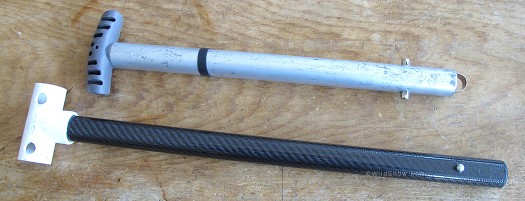
Conventional alu shovel shaft above would weigh about 8 ounces at 20 inch length. I didn't compare weight to the actual G3 brand shaft, as it's extendable and quite heavy in comparison. The weight savings of composite would be quite significant if used for an extendable shaft.
Available backpack interior height was measured, 20 inches available. Composite tube was then cut with abrasive wheel, button catch installed, and plug inserted in bottom end. Handle is schedule 40 PVC 3/4 inch T fitting, one leg of T bored out tight then press fit over tube after heating, fixation via PVC plumbing glue and a rivet to prevent rotation. Handle weighs nearly as much as the whole shaft, so speed holes added to reduce disappointment. Total project time for first iteration using PVC handle: two hours including hardware store run. G3 Guide shovel blade is heavy and a bit small (though it works well for certain applications), next project will be making this same style shaft for a BCA blade, this will be a tougher project due to BCA oval shaft shape. Or perhaps I can find another shovel blade that’s acceptable but has a round instead of oval shaft socket.
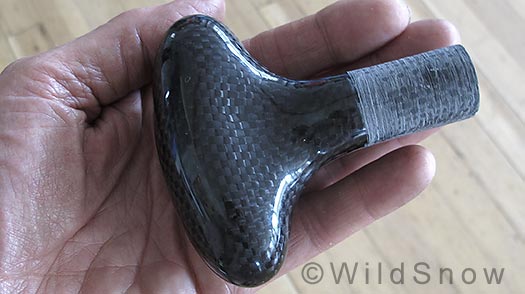
Carbon fiber paddle handle floats at 32 grams, is easily installed in carbon shaft using epoxy.
Part II: I ordered a carbon fiber white-water paddle handle from Zaveral Racing Equipment. The handle is beautifully made, foam core with internal strengthening strut, super light at 1.1 oz (32 grams), saving just under an ounce vs PVC handle — significant when we’re talking total project weights of around 5 ounces. For a good bond between handle and shaft, the handle tang was first enlarged by laying up a few layers of fiberglass mat and epoxy, molded inside a spare chunk of shaft material, using release layer made from plastic bag. With the handle tang nicely shaped, it was then glued it into the shovel shaft using epoxy. A tight fit with quite a bit of surface area insures a good bond. Total project time to install carbon handle: about 1 hour.
Results: Using PVC handle total weight is 5.4 ounce shaft versus conventional of same length weighing about 8 ounces, saving 2.6 ounces (74 grams). Using carbon paddle handle, total is 4.7 oz, saving 3.3 ounces (93.56 grams) over the 8 ounce conventional shaft. After the full-carbon shaft was constructed, another was made with an aluminum adapter for oval shaft BCA shovel blades; weight 5.3 ounces (resulting in a quite effective and strong shovel that weighs almost exactly one pound).
Conclusion: Overall nice. Composite handle necessary before weight saving is significant. Doing this one-off demo project was expensive, but mass producing this could conceivably result in cost well within the weight savings vs cost balance for many active backcountry skiers. Regarding the composite handle, a more budget friendly version could be constructed as a simple T handle using a cross piece of smaller carbon tube inserted into the larger shaft. Doing this for the one-of would necessitate ordering another longer stick of tubing, using the paddle handle was more fun and probably cost about the same.
WildSnow.com publisher emeritus and founder Lou (Louis Dawson) has a 50+ years career in climbing, backcountry skiing and ski mountaineering. He was the first person in history to ski down all 54 Colorado 14,000-foot peaks, has authored numerous books about about backcountry skiing, and has skied from the summit of Denali in Alaska, North America’s highest mountain.
